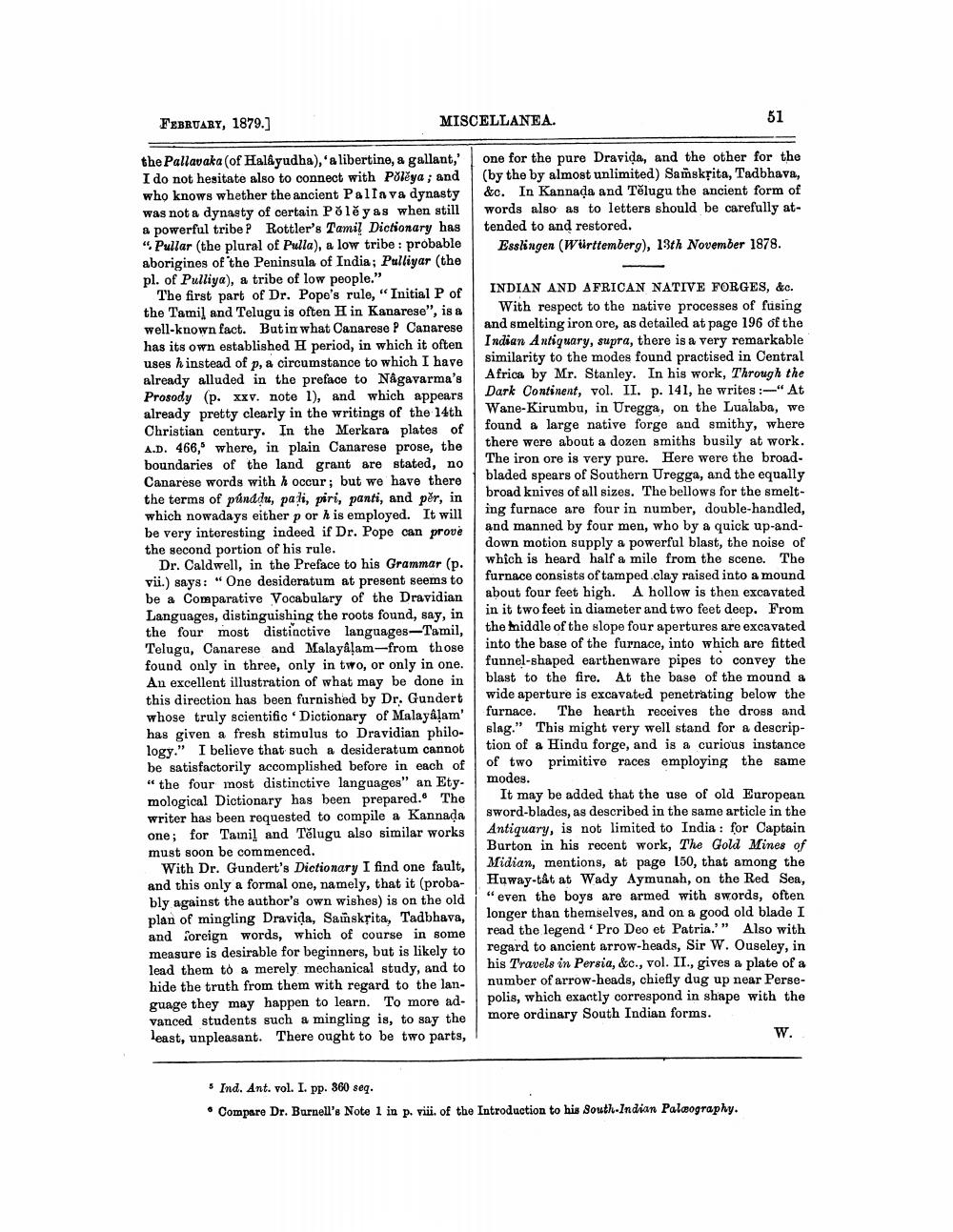________________
FEBRUARY, 1879.]
MISCELLANEA.
one for the pure Dravida, and the other for the (by the by almost unlimited) Samskrita, Tadbhava, &c. In Kannada and Telugu the ancient form of words also as to letters should be carefully attended to and restored.
Esslingen (Württemberg), 13th November 1878.
the Pallavaka (of Halayudha), a libertine, a gallant, I do not hesitate also to connect with Polěya ; and who knows whether the ancient Palla va dynasty was not a dynasty of certain Polěy as when still a powerful tribe P Rottler's Tamil Dictionary has "Pullar (the plural of Pulla), a low tribe : probable aborigines of the Peninsula of India; Pulliyar (the pl. of Pulliya), a tribe of low people."
The first part of Dr. Pope's rule, "Initial P of the Tamil and Telugu is often H in Kanarese", is a well-known fact. Butin what Canarese P Canarese has its own established H period, in which it often uses h instead of p, a circumstance to which I have already alluded in the preface to Någavarma's Prosody (p. xxv. note 1), and which appears already pretty clearly in the writings of the 14th Christian century. In the Merkara plates of A.D. 466,9 where, in plain Canarese prose, the boundaries of the land grant are stated, no Canarese words with h occur; but we have there the terms of púnddu, pali, piri, panti, and pår, in which nowadays either p or his employed. It will be very interesting indeed if Dr. Pope can prove the second portion of his rule.
Dr. Caldwell, in the Preface to his Grammar (p. vii.) says: “One desideratum at present seems to be a Comparative Vocabulary of the Dravidian Languages, distinguishing the roots found, say, in the four most distinctive languages-Tamil, Telugu, Canarese and Malayalam-from those found only in three, only in two, or only in one. An excellent illustration of what may be done in this direction has been furnished by Dr. Gundert whose truly scientific Dictionary of Malayalam has given a fresh stimulus to Dravidian philology." I believe that such a desideratum cannot be satisfactorily accomplished before in each of
the four most distinctive languages" an Ety. mological Dictionary has been prepared. The writer has been requested to compile a Kannada one; for Tamil and Telugu also similar works must soon be commenced.
With Dr. Gundert's Dictionary I find one fault, and this only a formal one, namely, that it (probably against the author's own wishes) is on the old plan of mingling Dravida, Samskrita, Tadbhava, and foreign words, which of course in some measure is desirable for beginners, but is likely to lead them to a merely mechanical study, and to hide the truth from them with regard to the language they may happen to learn. To more advanced students such a mingling is, to say the least, unpleasant. There ought to be two parts,
INDIAN AND AFRICAN NATIVE FORGES, &c.
With respect to the native processes of fusing and smelting iron ore, as detailed at page 196 of the Indian Antiquary, supra, there is a very remarkable similarity to the modes found practised in Central Africa by Mr. Stanley. In his work, Through the Dark Continent, vol. II, p. 141, he writes :-"At Wane-Kirumbu, in Uregga, on the Lualaba, we found a large native forge and smithy, where there were about a dozen smiths busily at work. The iron ore is very pure. Here were the broadbladed spears of Southern Uregga, and the equally broad knives of all sizes. The bellows for the smelting furnace are four in number, double-handled, and manned by four men, who by a quick up-anddown motion supply a powerful blast, the noise of which is heard half a mile from the scene. The furnace consists of tamped.clay raised into a mound about four feet high. A hollow is then excavated in it two feet in diameter and two feet deep. From the middle of the slope four apertures are excavated into the base of the furnace, into which are fitted funnel-shaped earthenware pipes to convey the blast to the fire. At the base of the mound a wide aperture is excavatud penetrating below the furnace. The hearth receives the dross and slag." This might very well stand for a description of a Hindu forge, and is a curious instance of two primitive races employing the same modes.
It may be added that the use of old European sword-blades, as described in the same article in the Antiquary, is not limited to India : for Captain Burton in his recent work, The Gold Mines of Midian, mentions, at page 150, that among the Huway-tât at Wady Aymunah, on the Red Sea, "even the boys are armed with swords, often longer than themselves, and on a good old blade I read the legend Pro Deo et Patria.'" Also with regard to ancient arrow-heads, Sir W. Ouseley, in his Travels in Persia, &c., vol. II., gives a plate of a number of arrow-heads, chiefly dug up near Persepolis, which exactly correspond in shape with the more ordinary South Indian forms.
W.
5 Ind. Ant. vol. I. pp. 360 seq. • Compare Dr. Barnell's Note 1 in p. viii. of the Introduction to his South Indian Palæography,




